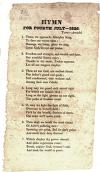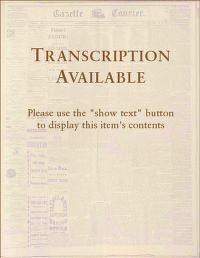|

"HYMN - For Fourth July--1826"

"Temperance and Abolition Celebration at North Leverett" article from the Gazette and Courier newspaper

Toasts for Independence

"Mr. Editor" article for the Gazette and Courier newspaper on the doings of the Sabbath school in South Deerfield for July 4th
|
Summary and Objective
Through review of primary documents and participation in an historical re-enactment, students will compare the modern celebration of the Fourth of July with that of early 19th century New England so that students will understand its earlier importance as a significant and widely celebrated holiday.
Teaching Plan
Step 1.
Students will brainstorm about holidays which they currently observe in some way and will guess which holidays were considered most important in New England in the late 18th and early 19th centuries. Explain to students that Thanksgiving was considered the most important holiday at the time, but that, perhaps even more surprisingly, the Fourth of July was certainly a close second.
Step 2.
On a chart, compare the early 21st century version of this holiday with the early 19th century version. Begin by listing THEMES that come to students' mind when thinking about the holiday,and ACTIVITIES students might participate in on this holiday.
Step 3.
Explain that students will research primary documents from the early 19th century to complete the chart.
Step 4.
Break up students into four groups. Distribute copies of one of the documents from the digital collection to each group: Hymn-For Fourth July-1826; Temperance and Abolition Celebration at North Leverett, July 5, 1841; Toasts for Independence, 1807-1809; and Mr Editor article...on the doings of the Sabbath School in South Deerfield for July 4th, 1841. Original and transcripted copies should be viewed where possible, and you may want to further translate one copy into modern day language and assign this document to a group containing ESL students and/or lower level readers.
Step 5.
Assist students in understanding the documents, noting important themes of temperance and abolitionism, and in cooperatively filling in the Comparison Chart. You may want to read the Fourth of July chapter in "Little House on the Prairie" for further discussion.
Step 6.
Plan an historic reenactment of a Glorious Fourth celebration (perhaps on June 4th?), complete with patriotic orations, excerpted recitations of Declaration of Independence, hymns, patriotic songs, toasts (using apple juice or cider) and a picnic of traditional foods. Consider using modern day equivilents, while retaining the spirit of the earlier themes. For example, temperance references can be substituted with anti-smoking or anti-drug slogans, abolitionist references can be substituted with anti-bias orations, and students can consider what contemporary music may be considered 'patriotic', etc.
|




